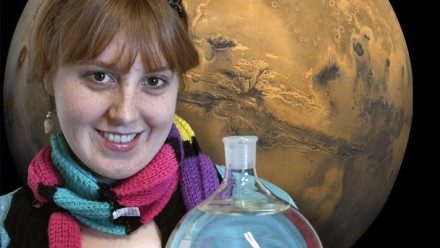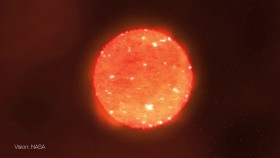Do Martians live underground?
ANU ScienceWise Magazine - Spring 2010
All living things on Earth require liquid water at some point in their life cycle to survive. Since the other rocky planets in the Solar System formed from essentially the same raw materials as the Earth and physics and chemistry are the same there, it’s a reasonable assumption that any extraterrestrial life may also have evolved around water.
This is the approach adopted by most scientists engaged in the search for extraterrestrial life and is well summed up by NASA’s follow the water philosophy in their Martian life exploration. But will just any old water support life? This is a question that forms a central theme in the research of Eriita Jones, who is completing her PhD at the ANU Research School of Astronomy and Astrophysics. She’s investigating how hot, how cold and how salty water can be and still support life and where exactly on a planet such water is likely to exist.
“We’re interested in water on other planets such as Mars,” Eriita says, “But we can learn a huge amount by looking at water here on Earth. And of course it’s a lot easier to gather data on Earth than Mars.” As part of this research Eriita has been working with Dr Charley Lineweaver on developing a computer model of water on the Earth from ice on the peak of Mount Everest to the depths of the oceans.
“Water behaves quite differently in different pressure and temperature regimes,” Eriita explains“ We know for example that if water is salty enough it can remain liquid at -20°C and still support life. We also see life in pressurised thermal vents at 120°C but that doesn’t mean we should jump to the conclusion that ‘water equals life’. When we looked at all the places on Earth where water can be found, there were some quite surprising results. We found that if you counted up the molecules of liquid water that aren’t hospitable to life, only about 1 per cent of the liquid water on Earth is ‘uninhabited’, and that 1 per cent is incredibly spread out in the crust and upper mantle. However if you look at the volume of Earth with liquid water, 88% of that volume is uninhabited given current limits on life.”
Dr Lineweaver adds “Even after roughly four billion years of evolution, life on Earth has not been able to figure out how to live in some water on this planet. The fundamental limits that we have identified may be more than just limits on terrestrial life – they may apply to any terrestrial-like life in the universe.”
Having created a realistic model of the water on Earth and the life within it, the next step was to create a similar model for Mars. This also incorporated uncertainties in the parameters, but because the data is far more limited for Mars, the uncertainties are of course, larger.
Generally the temperature and atmospheric pressure on Mars is too low for liquid water to flow on the surface. What tends to happen is that exposed ice sublimes directly into water vapour. However, very occasionally conditions may be just right for some liquid water to exist. And of course once you get below the surface, it could be a very different story.
On Earth the temperature usually decreases initially as you go underground due to the lack of solar heating. However once you get a little deeper it begins to increase at the rate of about 25 degrees per kilometre down. From what we know of Mars, the situation is similar except that the temperature increase is a more modest 5° per km. So according to Eriita’s and Charley’s model, it’s highly likely that liquid water will be found a few kilometres below the surface and that it may exist closer to the surface at least on a seasonal basis.
If conditions in such shallow seasonally wet soil became very much less hospitable during the harsh Martian winter, that may not in itself exclude life. “Data from the Vostok ice core confirms the presence of dormant life even at -40°C,” Eriita explains, ”So it wouldn’t be out of the question for a Martian microorganism to grow and multiply when liquid water was present then lie dormant in the ice when conditions were less favourable.”
The value of such a model of temperature, pressure and the various phases of water in a Martian environment is that it may help in targeting the search for life there. For example if a spacecraft visited the Earth and sampled the crust and upper mantle randomly, it would have a significant chance of not detecting life. And compared to Mars, the Earth teams with life. So when targeting Mars missions to look for life, knowing the best place to look is especially important in achieving success. “Given the conditions on Mars, we think that there’s a much better chance of life existing underground than on the surface” Eriita explains, “So two of the key questions we’re hoping to answer here is; Where do you have to dig and how deep do you have to go on Mars to find liquid water and that potential for life?”












